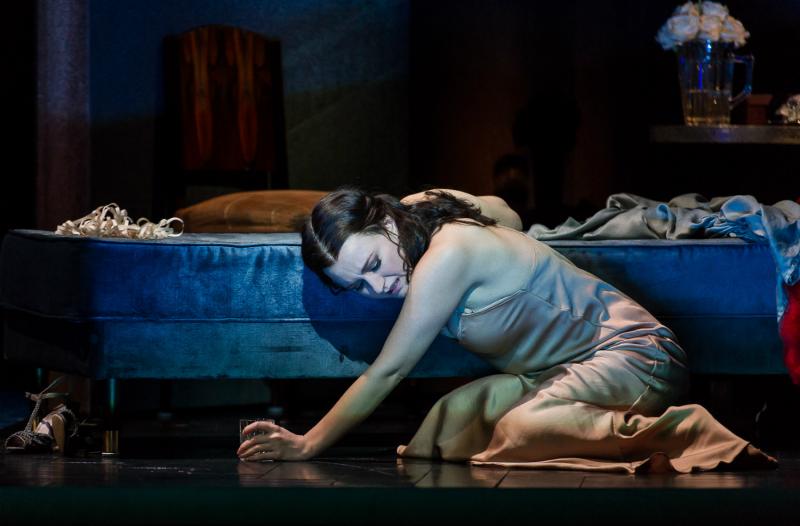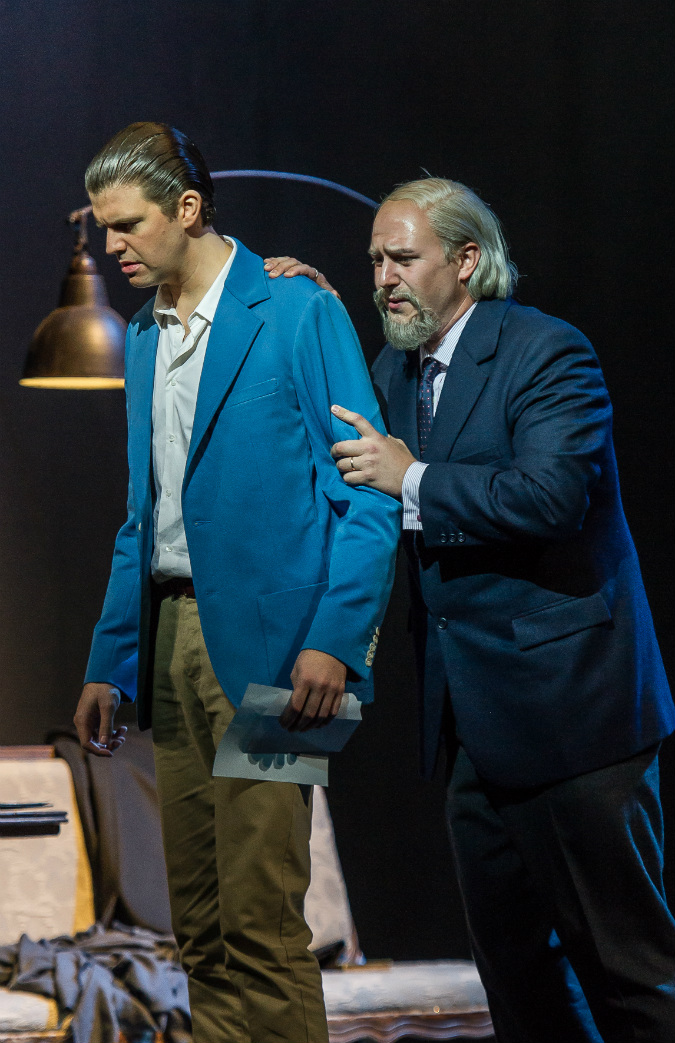La Traviata, Glyndebourne Tour | reviews, news & interviews
La Traviata, Glyndebourne Tour
La Traviata, Glyndebourne Tour
Violetta's fall re-imagined as psychological crisis in Verdi's evergreen tragedy

Usually, anyone bringing tuberculosis and transgression to the regional centres of Woking, Norwich and Milton Keynes would meet redoubtable opposition. In the case of Glyndebourne’s new touring production of La traviata, that would be a shame, because this is a lean, powerful version that reaches straight for the heart and gives it a good squeeze.
This version places the psychology of the central couple’s relationship at its heart. From the first, the stage acting is closely observed, with effective gestures throughout, such as Violetta’s refilling of Alfredo’s champagne glass just before his toast to love. Alfredo’s no chest-beating macho, but a nervous and slightly gauche young man on the brink of self-discovery, and the gangling Borichevsky captures his faltering journey well. That vulnerability seems to be the attraction for Violetta, who, finally looking for love rather than an employer for her courtesanship, has tired of the likes of Baron Douphol.
In a rather brilliant re-focusing of Violetta’s character, director Tom Cairns seems to see her tragedy as psychological. There was, tellingly, very little of the consumptive coughing traditional in the role: from Act One, where she’s unsure of his love, to Act Two, when she is easily deterred by Alfredo’s father, Giorgio Germont, and wonders aloud whether, as a courtesan, she can deserve or achieve real love, it’s a crisis of confidence as much as anything. When, at the end of Act Two, Violetta tells Alfredo he can’t understand her love, the accusing eyes of the party upon her, she seems more likely to be high, drunk, or depressed than dying of tuberculosis. Being trapped in the skin of a courtesan seems to be what kills her.
Both leads needed 15 minutes to warm to their roles, until which there was a brittle, metallic edge to their voices. They shared a light, lyrical quickness, well adapted for the many scenes of dialogue. Neither (yet) has the power to fill the hall, or send 240 volts down the spine, but they were appropriately matched to characters defined by anxiety and struggle, and by the end, Dubrovskaya in particular was sounding very fine. The Glyndebourne Touring Orchestra under David Afkham accompanied sensitively. What their sound occasionally lacked in lustre it made up for in the sprung vigour of the bustling party scenes, where tension is powerfully evoked by the contrast between the fine lines of the upper, and gutsy pulse of the lower strings.
 Alfredo’s father, Giorgio Germont, is a more complex figure than the pompous, paternal buffoon of operatic stereotype. Quick to realise Violetta’s sensitivity and to regret his own interference, his rather woolly depiction here, by Roman Burdenko (pictured right with Zach Borichevsky), had more stuffing than shirt about it, a feature unfortunately symbolised by the failure of the glue on his false moustache. It was hard to believe that even a demoralised Violetta would find this figure, trailing strands of moustache from his pallid chops, at all imposing.
Alfredo’s father, Giorgio Germont, is a more complex figure than the pompous, paternal buffoon of operatic stereotype. Quick to realise Violetta’s sensitivity and to regret his own interference, his rather woolly depiction here, by Roman Burdenko (pictured right with Zach Borichevsky), had more stuffing than shirt about it, a feature unfortunately symbolised by the failure of the glue on his false moustache. It was hard to believe that even a demoralised Violetta would find this figure, trailing strands of moustache from his pallid chops, at all imposing.
The period-lite set was for me the production’s weakest feature, though you can see what they’re getting at. Act One’s two huge curved screens, one red and one blue, aspire to suggest the drama’s public-private, Alfredo-Violetta dichotomies, though they have an unhelpful, Travelodge blandness, and the red-blue colour scheme does tend to make one fear that at any moment Dave and Ed will burst onto the stage, bandying tax cuts. Act Two was, if anything, worse, with only a backdrop – a kind of blurry, Monet-shopping-bag floral wash – to suggest the rustic intimacy of the couple’s retreat. Act Three worked best, the poignantly diminutive chandelier over Violetta’s bed suggestive of her fall from splendour. Costumes are, for the most part, non-committal rather than hugely evocative, though Violetta’s combination of elegant silvery dress – a silver that changes so easily to a leaden corpse’s pallor -– and scarlet courtesan’s gown seemed cleverly symbolic of her split identity.
Each act began with Violetta lying on her bed, lit in a silvery, spectral moon-wash. It’s an evocative touch, which mirrors the yearning string theme repeated from the overture onwards. By the moment of Violetta’s final collapse, there’s almost, dare one say it, a touch of liebestod about the way she's only free to love in death.
This is a refreshing production, which dispenses with fusty moralising and tired critiques of a bourgeois morality that is difficult to make real for today’s audiences. As the curtain comes down on Violetta’s corpse, still lit in ghostly white, but now centre stage, we understand Violetta’s ultimately fatal struggle to have been that which we find at the heart of most great drama, to be yourself.
- Glyndebourne Tour's La traviata is perfomed at Glyndebourne on October 7, 11, 17, 22 and 25, before going on nationwide tour.
rating
Explore topics
Share this article
The future of Arts Journalism
You can stop theartsdesk.com closing!
We urgently need financing to survive. Our fundraising drive has thus far raised £49,000 but we need to reach £100,000 or we will be forced to close. Please contribute here: https://gofund.me/c3f6033d
And if you can forward this information to anyone who might assist, we’d be grateful.

Subscribe to theartsdesk.com
Thank you for continuing to read our work on theartsdesk.com. For unlimited access to every article in its entirety, including our archive of more than 15,000 pieces, we're asking for £5 per month or £40 per year. We feel it's a very good deal, and hope you do too.
To take a subscription now simply click here.
And if you're looking for that extra gift for a friend or family member, why not treat them to a theartsdesk.com gift subscription?
more Opera
 BBC Proms: The Marriage of Figaro, Glyndebourne Festival review - merriment and menace
Strong Proms transfer for a robust and affecting show
BBC Proms: The Marriage of Figaro, Glyndebourne Festival review - merriment and menace
Strong Proms transfer for a robust and affecting show
 BBC Proms: Suor Angelica, LSO, Pappano review - earthly passion, heavenly grief
A Sister to remember blesses Puccini's convent tragedy
BBC Proms: Suor Angelica, LSO, Pappano review - earthly passion, heavenly grief
A Sister to remember blesses Puccini's convent tragedy
 Orpheus and Eurydice, Opera Queensland/SCO, Edinburgh International Festival 2025 review - dazzling, but distracting
Eye-popping acrobatics don’t always assist in Gluck’s quest for operatic truth
Orpheus and Eurydice, Opera Queensland/SCO, Edinburgh International Festival 2025 review - dazzling, but distracting
Eye-popping acrobatics don’t always assist in Gluck’s quest for operatic truth
 MARS, Irish National Opera review - silly space oddity with fun stretches
Cast, orchestra and production give Jennifer Walshe’s bold collage their all
MARS, Irish National Opera review - silly space oddity with fun stretches
Cast, orchestra and production give Jennifer Walshe’s bold collage their all
 Káťa Kabanová, Glyndebourne review - emotional concentration in a salle modulable
Janáček superbly done through or in spite of the symbolism
Káťa Kabanová, Glyndebourne review - emotional concentration in a salle modulable
Janáček superbly done through or in spite of the symbolism
 Buxton International Festival 2025 review - a lavish offering of smaller-scale work
Allison Cook stands out in a fascinating integrated double bill of Bernstein and Poulenc
Buxton International Festival 2025 review - a lavish offering of smaller-scale work
Allison Cook stands out in a fascinating integrated double bill of Bernstein and Poulenc
 Tosca, Clonter Opera review - beauty and integrity in miniature
Happy surprises and a convincing interpretation of Puccini for today
Tosca, Clonter Opera review - beauty and integrity in miniature
Happy surprises and a convincing interpretation of Puccini for today
 Hamlet, Buxton International Festival review - how to re-imagine re-imagined Shakespeare
Music comes first in very 19th century, very Romantic, very French operatic creation
Hamlet, Buxton International Festival review - how to re-imagine re-imagined Shakespeare
Music comes first in very 19th century, very Romantic, very French operatic creation
 Falstaff, Glyndebourne review - knockabout and nostalgia in postwar Windsor
A fat knight to remember, and snappy stagecraft, overcome some tedious waits
Falstaff, Glyndebourne review - knockabout and nostalgia in postwar Windsor
A fat knight to remember, and snappy stagecraft, overcome some tedious waits
 Salome, LSO, Pappano, Barbican review - a partnership in a million
Asmik Grigorian is vocal perfection in league with a great conductor and orchestra
Salome, LSO, Pappano, Barbican review - a partnership in a million
Asmik Grigorian is vocal perfection in league with a great conductor and orchestra
 Semele, Royal Opera review - unholy smoke
Style comes and goes in a justifiably dark treatment of Handelian myth
Semele, Royal Opera review - unholy smoke
Style comes and goes in a justifiably dark treatment of Handelian myth
 Le nozze di Figaro, Glyndebourne review - perceptive humanity in period setting
Mostly glorious cast, sharp ideas, fussy conducting
Le nozze di Figaro, Glyndebourne review - perceptive humanity in period setting
Mostly glorious cast, sharp ideas, fussy conducting

Add comment